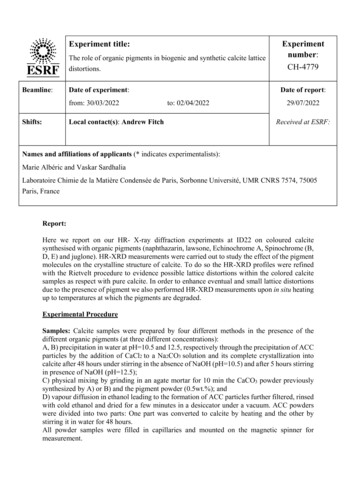
Transcription
The role of organic pigments in biogenic and synthetic calcite latticedistortions.Experimentnumber:CH-4779Date of experiment:Date of report:Experiment title:Beamline:from: 30/03/2022Shifts:to: 02/04/2022Local contact(s): Andrew Fitch29/07/2022Received at ESRF:Names and affiliations of applicants (* indicates experimentalists):Marie Albéric and Vaskar SardhaliaLaboratoire Chimie de la Matière Condensée de Paris, Sorbonne Université, UMR CNRS 7574, 75005Paris, FranceReport:Here we report on our HR- X-ray diffraction experiments at ID22 on coloured calcitesynthesised with organic pigments (naphthazarin, lawsone, Echinochrome A, Spinochrome (B,D, E) and juglone). HR-XRD measurements were carried out to study the effect of the pigmentmolecules on the crystalline structure of calcite. To do so the HR-XRD profiles were refinedwith the Rietvelt procedure to evidence possible lattice distortions within the colored calcitesamples as respect with pure calcite. In order to enhance eventual and small lattice distortionsdue to the presence of pigment we also performed HR-XRD measurements upon in situ heatingup to temperatures at which the pigments are degraded.Experimental ProcedureSamples: Calcite samples were prepared by four different methods in the presence of thedifferent organic pigments (at three different concentrations):A, B) precipitation in water at pH 10.5 and 12.5, respectively through the precipitation of ACCparticles by the addition of CaCl2 to a Na2CO3 solution and its complete crystallization intocalcite after 48 hours under stirring in the absence of NaOH (pH 10.5) and after 5 hours stirringin presence of NaOH (pH 12.5);C) physical mixing by grinding in an agate mortar for 10 min the CaCO3 powder previouslysynthesized by A) or B) and the pigment powder (0.5wt.%); andD) vapour diffusion in ethanol leading to the formation of ACC particles further filtered, rinsedwith cold ethanol and dried for a few minutes in a desiccator under a vacuum. ACC powderswere divided into two parts: One part was converted to calcite by heating and the other bystirring it in water for 48 hours.All powder samples were filled in capillaries and mounted on the magnetic spinner formeasurement.
Methods: HR-XRD measurements were performed at ID22 beamline, ESRF. For ourmeasurements, the beam energy was set to 35KeV and the beam size was 1.0x1.0 mm2 in crosssection. Si standard NIST 640c was used for calibration. The heating of the samples was carriedout by a heat blower available at the beamline and the temperature was increased from 25 C to450 C at a rate of 10 C/min and stopped for 20min at each relevant temperatures during HRXRD acquisition.Data acquisition and evaluation: X-ray scattering data were acquired using the flat panelPerkin Elmer XRD 1611CP3 detector, which is suited for total scattering measurements at highenergies. Recorded 2D patterns were processed using 2D powder diffraction data reductionsoftware available for calibration and data integration. The data integrated was plotted usingOrigin software. The Rietveld refinement was carried out using a script provided by ID22beamline scientist for the TOPAS software.ResultsHere, we report the results obtained for the syntheses A), B) and C) performed in the presenceof naphthazarin molecules for two different concentrations (20 and 100 µg/mL) (Figure1) asthese data are being summarized for a first publication, the data obtained for the others pigmentswill be analyzed in details in a second step.Figure 1. Naphthazarin-calcite powders obtained after A) precipitation in water at pH 10.5, B)precipitation in water at pH 12.5 and C) physical mixing of naphthazarin with CaCO3 previouslysynthesized at pH 10.5 and pH 12.5.Figure 2 A) shows the HR-XRD profiles of pure and naphthazarin-calcite powders confirmingthat all samples were indeed calcitic. Figure 2 B) displays the (104), (006) and (110) reflectionof geological calcite and pure calcite synthesized by precipitation in water at pH 10.5 and 12.5evidencing the difference in structure between the three samples. Calcite synthesized atpH 12.5 is less crystalline whereas once synthesized at pH 10.5 it is as crystalline as geologicalcalcite but present peak shift to lower 2Theta, suggesting higher lattice parameters as confirmedby the results of Rietveld refinement (Table 1). Lattice distortions were calculated as comparedto geological calcite. For pH 10.5, calcite lattice distrotions are isotropic with relatively lowΔc/c and Δa/a (0.05%) while for pH 12.5, lattice distortions are anisotropic with Δa/a quiteimportant (0.24%) and Δc/c very low (0.01%).
Figure 2. A) X-rays diffractograms of pure calcite and naphthazarin-calcite powderssynthesized at pH 10.5 and B) (104), (006) and (110) reflection of geological calcite ascompared to pure calcite synthesized at pH 10.5 and 12.5.Table1: Calcite lattice parameters extracted by applying Rietveld refinements to the HR-XRDprofiles of the different samples with one calcite phase (in red) and two calcite phases (in black).
The comparison of (104), (006), and (110) peaks of HR-XRD profiles of calcite synthesized atpH 12.5 without and with naphthazarin molecules suggests that the presence of pigmentintroduces a significant peak shift only for the (110) (Figure 3 A)). This is reflected in thecalculated anisotropic lattice distortions with Δa/a 0.12% and neglegible Δc/c .The comparison of (104), (006), and (110) peaks of HR-XRD profiles of calcite synthesized atpH 10.5 without and with naphthazarin molecules suggests that the presence of pigment doesnot introduce significant peak shift (Figure 3 B)). Indeed Δc/c 0.001-0.008% indicates thatthe lattice distortion in the c axis direction is negligible when compared to sea urchins spines(0.03%) or mollusk shells (0.1%). The addition of naphthazarin however only introduces abroadening of the peaks.In addition, it can be observed a peak splitting of the (110) peak suggesting the possibility ofanother phase in our system. Therefore, Rietveld refinement has been also perfomed with twodifferent calcite pahses (Table1). This sencondary peak is much broader than the main peaksuggesting smaller cristallites. However, this peak is also present in the pure synthetic calciteand is the most intense in the sample formed by physical mixing therefore, its origin must stillbe investigated.Figure 3. (104), (006) and (110) reflections of HR-XRD profiles once normalized of purecalcite, 20 and 100 µg/mL-naphthazarin-calcite synthesized at A) pH 12.5 and B) pH 10.5.One clue is its disappearing after heating (Figure 4). In situ heating experiments were conductedto reveal small calcite lattice distortions induced by the presence of pigments before and afterheating. In biogenic samples, 400 C is sufficient to guarantee most of the organic destructionand colors were observed to fade away at 200 C in sea urchin spines. Here, we observe that at400 C the color is still present even if changed from bleu to purple. However, despite thedisappearing of the peak splitting at 200 C no significant peak shift and slight peak broadeningare observed. At 200 C structural water associated (or not) with the pigment molecules mightbe the origin of this change of structure but furhter studies are needed.
Figure 4: Photographs of the color changes according to the temperature with the same ramp(10 C/min 20 min at each temerature) used for the HR-XRD experiements. HR-XRD profileswith normalized intensity after calclite thermal expansion correction of the (006) and (110)peaks for pure calcite and calcite 0.02mg/ml naphthazarin at 25 C, 200 C and 400 C.
Figure 2 B) displays the (104), (006) and (110) reflection of geological calcite and pure calcite synthesized by precipitation in water at pH 10.5 and 12.5 evidencing the difference in structure between the three samples. Calcite synthesized at pH 12.5 is less crystalline whereas once synthesized at pH 10.5 it is as crystalline as geological .











